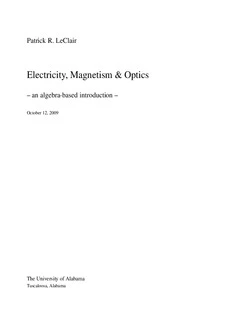
Electricity, Magnetism & Optics - The University of Alabama PDF
Preview Electricity, Magnetism & Optics - The University of Alabama
Patrick R. LeClair Electricity, Magnetism & Optics – an algebra-based introduction – October12,2009 The University of Alabama Tuscaloosa,Alabama Contents PartI Relativity 1 Relativity .................................................................. 3 1.1 FramesofReference..................................................... 3 1.2 MovingFramesofReference.............................................. 5 1.2.1 LackofaPreferredReferenceFrame................................. 6 1.2.2 RelativeMotion .................................................. 7 1.2.3 InvarianceoftheSpeedofLight..................................... 9 1.2.4 Principlesofspecialrelativity....................................... 10 1.3 ConsequencesofRelativity ............................................... 11 1.3.1 LackofSimultaneity .............................................. 11 1.3.2 TimeDilation .................................................... 12 1.3.3 LengthContraction................................................ 18 1.3.4 Timeandpositionindifferentreferenceframes ........................ 21 1.3.5 AdditionofVelocitiesinRelativity .................................. 24 1.3.6 Space-timeIntervals............................................... 28 1.4 Mass,Momentum,andEnergy ............................................ 33 1.4.1 RelativisticMomentum ............................................ 33 1.4.2 RelativisticEnergy................................................ 34 1.4.3 RelativisticMass ................................................. 37 1.5 Problems .............................................................. 38 PartII ElectricityandMagnetism 2 ElectricForcesandFields.................................................... 43 2.1 PropertiesofElectricCharges ............................................. 43 2.2 InsulatorsandConductors ................................................ 44 2.2.1 ChargingbyConduction ........................................... 45 2.2.2 ChargingbyInduction ............................................. 47 2.3 Coulomb’sLaw ......................................................... 48 2.4 TheElectricField ....................................................... 50 2.4.1 ElectricFieldLines ............................................... 51 2.4.2 Whathappenswhenwehavetwochargestogether? .................... 52 2.5 ConductorsinElectrostaticEquilibrium..................................... 53 2.6 FaradayCages .......................................................... 55 2.7 ThevandeGraaffGenerator .............................................. 56 2.8 Gauss’Law ............................................................ 58 2.8.1 ElectricFlux ..................................................... 58 2.8.2 Gauss’LawasaConservationLaw .................................. 60 2.8.3 Example:TheFieldAroundaSphericalChargeDistribution............. 60 2.8.4 Example:TheFieldAboveaFlatConductor .......................... 62 2.8.5 Example:TheFieldInsideandOutsideaHollowSphericalConductor..... 63 v vi Contents 2.8.6 Example:TheFieldDuetoaLineofCharge .......................... 65 2.9 Miscellanea ............................................................ 66 2.10 Problems .............................................................. 67 3 ElectricalEnergyandCapacitance............................................ 71 3.1 ElectricalPotentialEnergy................................................ 71 3.2 ElectricPotential........................................................ 74 3.2.1 ElectricPotentialandPotentialEnergyduetoPointCharges ............. 75 3.2.2 EnergyofaSystemofCharges...................................... 76 3.3 Potentialsandchargedconductors.......................................... 81 3.4 EquipotentialSurfaces ................................................... 82 3.5 PotentialDifferenceSourcesasCircuitElements ............................. 83 3.6 Capacitance ............................................................ 83 3.6.1 Parallel-PlateCapacitors ........................................... 84 3.6.2 Energystoredincapacitors ......................................... 85 3.6.3 CapacitorsasCircuitElements...................................... 87 3.6.4 CombinationsofCapacitors ........................................ 88 3.6.5 Capacitorswith(non-conducting)stuffinside.......................... 92 3.7 DielectricsinElectricFields .............................................. 94 3.8 Problems .............................................................. 98 4 CurrentandResistance...................................................... 103 4.1 ElectricCurrent ......................................................... 103 4.2 GettingCurrenttoFlow .................................................. 104 4.3 DriftVelocityandCurrent ................................................ 106 4.4 ResistanceandOhm’sLaw ............................................... 107 4.4.1 DriftVelocityandCollisions........................................ 108 4.4.2 Current,ElectricField,andVoltage .................................. 110 4.4.3 Resistance ....................................................... 111 4.4.4 ResistorsasCircuitElements ....................................... 112 4.4.5 ResistivityofMaterials ............................................ 114 4.4.6 VariationofResistancewithTemperature ............................. 115 4.5 ElectricalEnergyandPower .............................................. 116 4.6 Problems .............................................................. 117 5 Direct-CurrentCircuits...................................................... 119 5.1 SourcingVoltage........................................................ 119 5.2 SourcingCurrent........................................................ 122 5.3 CombinationsofResistors ................................................ 124 5.3.1 ResistorsinSeries ................................................ 124 5.3.2 ResistorsinParallel ............................................... 125 5.3.3 Example:aComplexResistorCombination ........................... 127 5.4 CurrentandVoltageMeasurementsinCircuits ............................... 129 5.4.1 MeasuringVoltage ................................................ 129 5.4.2 MeasuringCurrent ................................................ 130 5.5 Kirchhoff’sRulesandComplexdcCircuits.................................. 132 5.5.1 Example:analyzingasimpleparallelorseriescircuit ................... 133 5.5.2 Example:analyzingacomplexcircuit ................................ 134 5.6 RCCircuits............................................................. 136 5.7 Miscellaneous .......................................................... 138 5.8 Problems .............................................................. 139 Contents vii 6 Magnetism ................................................................. 145 6.1 MagneticFieldsandForces ............................................... 145 6.1.1 TheMagneticForce............................................... 147 6.1.2 MagnetismasaConsequenceofRelativity............................ 148 6.1.3 MagneticFieldofaLong,StraightWire .............................. 151 6.1.4 Handedness...................................................... 153 6.2 Ampe`re’sLaw .......................................................... 154 6.2.1 Ampe`re’sandGauss’Laws......................................... 155 6.3 TheMagneticFieldinVariousSituations.................................... 156 6.3.1 MotionofaChargedParticleinaMagneticField ...................... 156 6.3.2 MagneticForceonaCurrent-CarryingConductor ...................... 159 6.3.3 MagneticForceBetweenTwoParallelConductors ..................... 160 6.3.4 TorqueonaCurrentLoop .......................................... 162 6.3.5 MagneticFieldsofCurrentLoopsandSolenoids....................... 163 6.4 PermanentMagneticMaterials ............................................ 165 6.4.1 Non-permanentmagneticmaterials .................................. 167 6.4.2 Electromagnets................................................... 167 6.4.3 PermeabilityandMagnetsonYourFridge ............................ 168 6.5 Problems .............................................................. 170 7 InducedVoltagesandInductance ............................................. 171 7.1 InducedVoltagesandMagneticFlux ....................................... 171 7.2 Faraday’sLawofInduction ............................................... 172 7.3 Inductance ............................................................. 173 7.3.1 MutualInductance ................................................ 173 7.3.2 SelfInductance................................................... 174 7.4 Transformers ........................................................... 178 7.5 VoltageInducedbytheMotionofaConductorinaFIeld ...................... 179 7.5.1 Eddycurrentbrakes ............................................... 181 7.6 Generators ............................................................. 182 7.7 Asummaryofsorts...................................................... 183 8 acCircuitsandElectromagneticwaves ........................................ 185 8.1 ResistorsinanacCircuit ................................................. 185 8.2 CapacitorsinacCircuits.................................................. 187 8.3 InductorsinacCircuits................................................... 189 8.4 Filters ................................................................. 190 8.5 ElectromagneticWaves................................................... 192 8.5.1 Electromagneticfieldsofacceleratingcharges ......................... 192 8.5.2 ProductionofElectromagneticWavesbyanAntenna ................... 192 8.5.3 PropertiesofElectromagneticWaves................................. 193 8.5.4 EnergytransferredbyEMwaves .................................... 194 8.5.5 TheEMspectra................................................... 196 PartIII Optics 9 ReflectionandRefractionofLight ............................................ 199 9.1 TheNatureofLight...................................................... 199 9.1.1 WavePacketsandWave-ParticleDuality.............................. 200 9.2 ReflectionofLight ...................................................... 201 9.2.1 TheRayApproximation ........................................... 201 9.2.2 TheLawofReflection ............................................. 201 9.3 RefractionofLight ...................................................... 202 9.3.1 Snell’sLaw ...................................................... 204 9.3.2 DispersionandPrisms ............................................. 205 9.3.3 Rainbows........................................................ 207 viii Contents 9.4 TotalInternalReflection.................................................. 208 9.4.1 Fiberoptics ...................................................... 209 9.4.2 Multi-Touchscreens............................................... 210 10 Mirrors .................................................................... 213 10.1 FlatMirrors ............................................................ 213 10.1.1 Imageformation.................................................. 213 10.1.2 RayDiagrams.................................................... 215 10.1.3 ConventionsforRayDiagrams...................................... 216 10.1.4 Handedness...................................................... 217 10.2 SphericalMirrors........................................................ 217 10.2.1 ConcaveMirrors.................................................. 217 10.2.2 ConvexSphericalMirrors .......................................... 221 10.3 RayDiagramsforMirrors ................................................ 222 10.4 ParabolicMirrors........................................................ 223 11 Lenses ..................................................................... 227 11.1 Sphericalrefractingsurfaces .............................................. 227 11.1.1 FlatRefractingSurfaces ........................................... 230 11.2 SphericalLenses ........................................................ 230 11.3 Typesofsphericallenses ................................................. 234 SolutionstoProblems............................................................ 237 Bibliography.................................................................... 276 References.................................................................. 276 Part I Relativity Chapter 1 Relativity Thedifferencebetweentruthandfictionisthatfictionhasto makesense.–MarkTwain AbstractNearlyallofthemechanicalphenomenaweobservearounduseverydayhavetodowith objectsmovingatspeedsrathersmallcomparedtothespeedoflight.TheNewtonianmechanicsyou learnedinpreviouscourseshandledthesecasesextraordinarilywell.Asitturnsout,however,New- tonianmechanicsbreaksdowncompletelywhenanobject’sspeedisnolongernegligiblecompared to the speed of light. Not only does Newtonian mechanics fail in this situation, it fails spectacu- larly, leading to a variety of paradoxical situations. The resolution to these paradoxes is given by thetheoryofrelativity,oneofthemostsuccessfulandaccuratetheoriesinallofphysics,whichwe willintroduceinthischapter.Natureisnotalwayskind,however,andtheconsequencesofrelativity seem on their face to flout common sense and our view of the world around us. We are used to the notion that our position changes with time when we are in motion, but relativity implies that passage of time itself changes when we are in motion. Nevertheless, we shall see that relativity is aninescapableconsequenceofafewsimpleprinciplesandexperimentalfacts.Moreover,asitturns out,thisnewdescriptionofnatureiscriticalforproperlyunderstandingelectricityandmagnetism, optics,andnuclearphysics...mostoftherestofthiscourse! 1.1 FramesofReference Describingmotionproperlyusuallyrequiresustochooseacoordinatesystem,andanoriginfrom whichtomeasureposition.Whythisissoismoreclearwhenweconsiderthedifferencebetween distanceanddisplacement.Forexample,wecansaythatapersonmovesthroughadisplacementof 10meters,∆x=10m,inaparticulardirection,e.g.,totheright.Thisdoesnotdescribetheposition ofthepersonatall,onlythechangeinthatperson’spositionoversometimeinterval. Describingpositionitselfrequiresustochoosefirstacoordinatesystem(suchascartesian,spher- ical,etc.),andalsoanoriginforthiscoordinatesystemtodefineour“zero”position.Theessential difference is that displacement is independent of the coordinate system we choose, but position is not.Withoutchoosingacoordinatesystem,wecanonlysaythatthepersonhasrun10minacertain timeinterval,movingfromx tox . i f As a concrete example, consider Fig. 1.1a. This illustrates a person moving 10m to the right, whichperfectlydescribesadisplacement∆x.Wewillchooseanx−ycartesiancoordinatesystem, whichwewillcallO,withitsoriginattheperson’sstartingpoint.Inthissystem,wecandescribe theinitialandfinalpositionsPO andPO inthiscoordinatesystemasPO=(0,0)andPO=(x ,0)= i f i f f (∆x,0). This is shown in Fig. 1.1b. The displacement is the same as it was without a coordinate system.Inthischapterwewillusetheconventionthatsuperscriptsrefertothecoordinatesystemin whichthequantityinquestionwasmeasured. What happens if we if we instead choose a different coordinate system O0, Fig. 1.1c, identical toOexceptthatitsoriginisshifteddownwardbyy andtotheleftbyx?Nowtheinitialandfinal i i positionsofthepersonarePO0=(x,y)andPO0=(x ,y ).Still,thedisplacement∆xisthesame,as i i i f f f youcaneasilyverify.NomatterwhetherweobservethepersonfromtheOorO0system,wewould describethesamedisplacement,eventhoughtheactualpositionsarecompletelydifferent. 3 4 1 Relativity (a) ∆x=10m (b) y O x ∆x=x −0=x (0,0) (xf,0) f f ∆y =0 (c) x i ∆x! =∆x yi (xi,yi) (xf,yf) ∆y! =0 ! y O! x! Fig.1.1 Displacementisindependentofthecoordinatesystemwechoose,butpositionisnot.(a)Withoutchoosing acoordinatesystem,wecanonlysaythatthepersonhasrun10minacertaintimeinterval,movingfromxitoxf.(b) Ifwechooseanx−ycoordinatesystemOcenteredwithitsoriginontheperson’sstartingpointxi,wecandescribe theinitialandfinalpositionsasPiO=(xi,0)andPfO=(xf,0).Thedisplacementisthesame.(c)Ifwechooseanew coordinatesystemO0,identicaltoOexceptshifteddownwardbyyi andtotheleftbyxi,nowtheinitialandfinal positionsarePiO0=(xi,yi)andPfO0=(xf,yi).Still,thedisplacementisthesame. Inspecialrelativity,thissimplesituationnolongerholds-observersindifferentcoordinatesys- temsdonotnecessarilydescribeeventhesamedisplacement,muchlessthesameposition.Fortu- nately, the corrections of special relativity to the Newtonian mechanics you have already learned areonlyappreciableatveryhighvelocities(non-negligiblecomparedtothespeedoflight),andfor mosteverydaysituationsourusualintuitionisstillvalid. Inanycase,particularlythosecaseswhererelativisticeffectsareimportant,itiscruciallyimpor- tantthatwespecifyinwhichcoordinatesystemquantitieshavebeenmeasured.Wewillcontinueto dothiswithasuperscriptofsomesorttospecifythecoordinatesystem,andasubscriptofsomesort tofurtherdescribewhatisbeingmeasuredwithinthatsystem.Whenweonlyhavetwoframes,like theexampleabove,wewilloftenjustuseaprime(0)totellthemapart.Inthepreviousexample,this meanswewoulduseP0 insteadofPO0,andjustP insteadofPO.Itseemspedanticnow,butcareful f f i i bookkeepingistheonlythingsavingusfromterribleconfusionlater! Coordinatesystemnotationexamples: xO =xOfinalxpositionofanobjectmeasuredintheOcoordinatesystem final f vO0 ≡v0 velocityofacarmeasuredintheO0coordinatesystem car car PO0≡P0=(x0,y0)finalpositionofanobjectmeasuredintheO0coordinatesystem f f f i Finally, a word on terminology. In relativity, it is common to use “reference frame” in place of “coordinatesystem,”tomakeexplicitthefactthatourcoordinatesystemandoriginarethepointof referencefromwhichwemeasurephysicalquantities.Wewillusebothphrasingsinterchangeably fromhereonout.
Description: